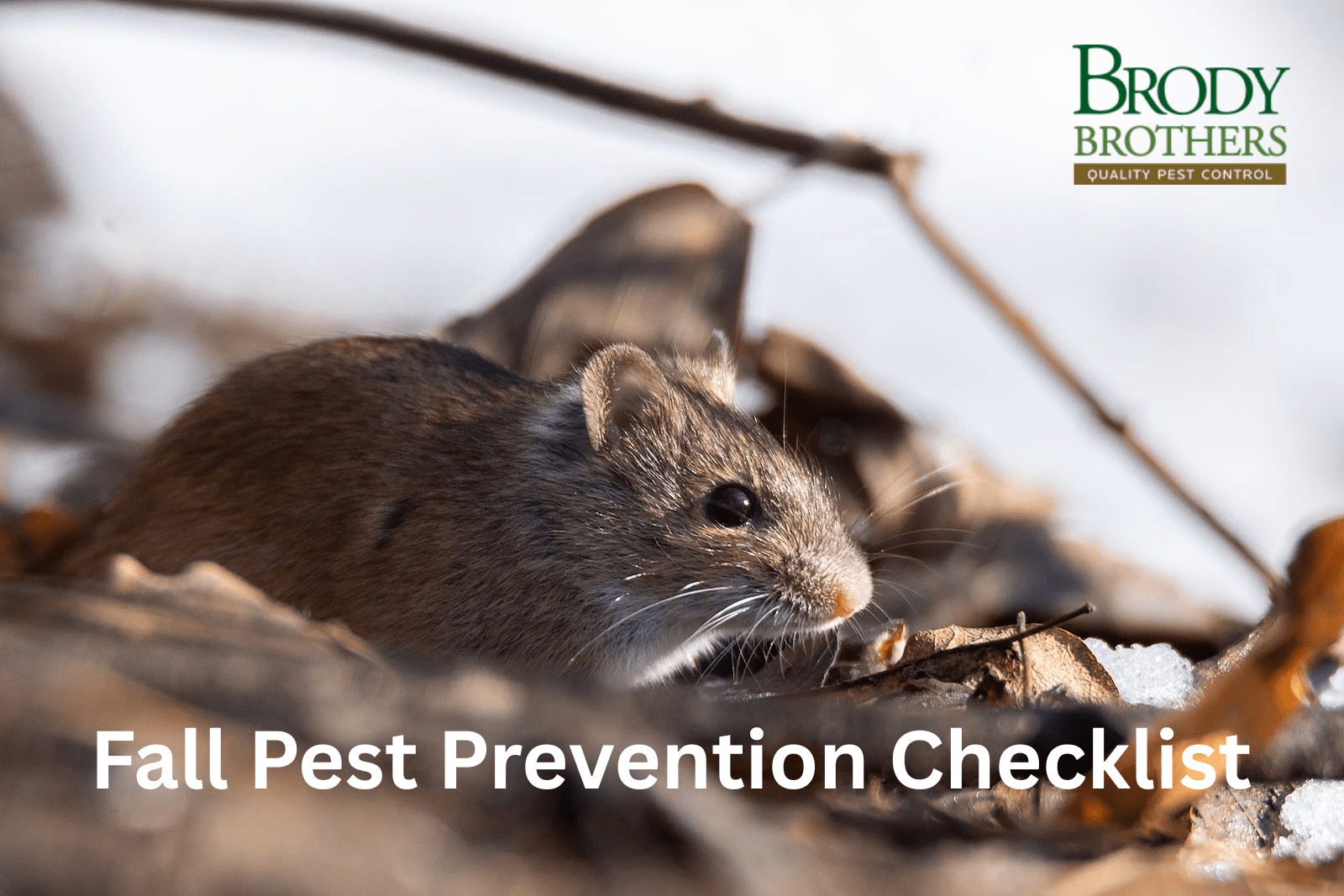
As autumn settles over Maryland, cooler weather brings more than just crisp air and colorful leaves. It also drives pests indoors. Rodents, spiders, and stink bugs that spent the summer outdoors begin searching for warm, sheltered places to overwinter. Unfortunately, that often means your home.
Once these pests get inside, they can multiply quickly, cause property damage, and even pose health risks. The best defense is a strong offense: sealing entry points and removing attractants before they arrive. At Brody Brothers Pest Control, we’ve helped Maryland homeowners protect their homes for decades. Below, we’ve created a comprehensive fall pest prevention checklist to help you stay one step ahead.
- Seal All Possible Entry Points
Pests are opportunistic and persistent. Mice can squeeze through holes as small as a pencil, and insects like stink bugs need only a hairline crack to get inside. Conduct a thorough inspection of your home’s exterior and interior, and seal anything that looks suspicious.
- Inspect your foundation, siding, and brickwork for cracks or gaps and seal them with High quality exterior sealant . Spray foam and steel wool are not permanent and rodents can chew through them.
- Replace damaged weatherstripping around windows and doors to eliminate drafts and pest entry points.
- Repair torn screens and replace damaged door sweeps to all exterior doors.
- Seal around utility lines, pipes, vents, and cable entry points. These are common rodent highways.
- Install appropriate screens over attic vents and use chimney caps to block wildlife and larger pests.
According to the EPA’s Integrated Pest Management (IPM) guidelines, sealing entry points is one of the most effective and environmentally responsible pest prevention strategies.
- Maintain a Clean and Pest-Resistant Exterior
Your yard is the first line of defense against fall pests. By reducing hiding spots and potential nesting areas near your home, you make it far less inviting.
- Trim trees, shrubs, and vines so they don’t touch your roof or walls. These can act as pest bridges.
- Rake leaves and remove yard debris quickly, as these materials attract insects and rodents seeking shelter.
- Store firewood at least 20 feet away from your home and elevate it off the ground to prevent rodent nests.
- Clean gutters and downspouts to avoid standing water and moisture that attract pests.
- Inspect siding, soffits, and rooflines for damage and repair them before pests can exploit them.
Even a few small changes outdoors can dramatically reduce the number of pests trying to make their way inside.
- Eliminate Indoor Attractants
If pests do make it inside, food, water, and shelter will encourage them to stay. Simple household habits can go a long way in making your home less appealing.
- Store dry goods in sealed, airtight containers. Cardboard packaging is no match for rodents.
- Wipe down kitchen counters and appliances daily and clean up spills promptly.
- Take out trash regularly and use bins with tight-fitting lids.
- Fix leaky pipes and dripping faucets to eliminate water sources.
- Declutter storage areas like basements, garages, attics, and closets. Pests love undisturbed spaces.
By addressing these attractants, you make your home inhospitable to pests that might otherwise settle in for the season.
- Know the Behavior of Common Fall Invaders
Understanding what pests are looking for in fall can help you target your prevention efforts more effectively.
- Rodents: Mice and rats seek warmth and food, often nesting in basements, attics, and walls. They chew through insulation and wiring and can spread diseases like hantavirus and salmonella.
- Spiders: These predators follow insect prey indoors. Most are harmless, but their webs and presence can still be unsettling. Regular cleaning and sealing gaps can reduce their activity.
- Stink Bugs: Drawn indoors to overwinter, stink bugs are not harmful but can invade in large numbers and release an unpleasant odor when disturbed.
Recognizing signs of activity early, such as droppings, chewed materials, or insect clusters near windows, allows for quicker intervention.
- Schedule a Professional Fall Inspection
Even the most diligent homeowner can miss hidden vulnerabilities. Professional pest control technicians are trained to identify subtle signs of pest activity and seal potential entry points you may overlook.
A fall inspection offers several key benefits:
- Comprehensive property assessment inside and out.
- Early detection of pest activity before it escalates.
- Preventive treatments tailored to seasonal pest pressures.
- Customized recommendations to keep your home protected all winter.
A proactive approach not only prevents infestations but also saves you time, money, and stress later in the season.
Protect Your Home Before Pests Move In
Once pests are inside, removal can become more difficult and costly. Take steps now to safeguard your home against fall invaders.
Contact Brody Brothers Pest Control today to schedule your fall pest prevention inspection. Our experts will help you identify vulnerabilities, seal entry points, and ensure your home stays pest-free all season long.
Fall Pest Prevention FAQ
Q: When should I start preparing my home for fall pests?
A: Begin preparations in late summer through early fall (August to November). Sealing and cleaning before pests begin their search for warmth gives you the best chance to prevent infestations.
Q: What are the most common fall pests in Maryland?
A: Rodents, spiders, stink bugs, and ants are among the most frequent invaders. Rodents are particularly concerning due to their potential to spread disease and damage property.
Q: Are stink bugs dangerous?
A: No, stink bugs are not harmful to humans or pets, but they can invade homes in large numbers and release a foul odor when disturbed.
Q: Can DIY methods replace professional pest control?
A: DIY steps like sealing gaps and cleaning regularly are valuable, but they may not address hidden vulnerabilities or early signs of infestation. A professional inspection ensures complete protection and peace of mind.
Q: How often should I have my home inspected for rodent entry points ?
A: We recommend at least one inspection per year, ideally in the fall, (we do quarterly inspections and treatments).

